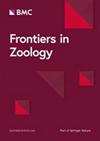Structure and function of the ovipositor of the encyrtid wasp Microterys flavus
IF 2.6
2区 生物学
Q1 ZOOLOGY
引用次数: 0
Abstract
Oviposition is crucial for the reproductive success of parasitoid insects and, hence, ovipositor structure and oviposition behaviour have probably played a central role in their adaptive evolution. However, various mechanical and functional aspects of the musculoskeletal ovipositor system are still not fully understood, especially within the enormously diverse parasitoid wasps, e.g. the minute and understudied Encyrtidae (Chalcidoidea). Some encyrtid wasps are specialized in parasitising insect plant pests and thus play an important ecological and economic role. We have examined all inherent cuticular elements and muscles of the ovipositor of the encyrtid wasp Microterys flavus to improve our understanding of its mechanics and mode of function. We provide a detailed 3D model based on a synchrotron X-ray phase-contrast microtomography (SR-µCT) dataset and have analysed microstructures on the cuticular ovipositor elements by using scanning electron microscopy (SEM). We have also conducted an in vivo documentation of the oviposition process of female M. flavus wasps on their host, the scale insect Coccus hesperidum. Based on morphological analyses, we have identified all elements of the musculoskeletal ovipositor system in M. flavus, consisting of two pairs of valvifers, three pairs of valvulae, the female T9 (9th abdominal tergum), and a set of nine paired ovipositor muscles. Three of these muscles (1st valvifer-genital membrane muscle, ventral 2nd valvifer-venom gland reservoir muscle, T9-genital membrane muscle) have only recently been discovered in pteromalid wasps but have not yet been described for encyrtids. Our behavioural analysis of the motion patterns during the various phases of parasitization has elucidated the oviposition process, which consists of penetration of the host’s body, assessment of the host’s internal organs, envenomation, egg deposition, and potential host feeding. Based on our studies of the structure of the ovipositor system of the encyrtid wasp M. flavus, we have developed a functional model of the underlying working mechanism of all ovipositor movements observed during the oviposition process, thereby improving our understanding of a possible key trait contributing to the evolutionary success of a highly diverse group of chalcidoid wasps.黄小蜂产卵器的结构与功能
产卵对拟寄生昆虫的繁殖成功至关重要,因此,产卵器的结构和产卵行为可能在它们的适应性进化中起着核心作用。然而,肌肉骨骼产卵器系统的各种机械和功能方面仍未完全了解,特别是在种类繁多的拟寄生蜂中,例如微小的和未被充分研究的蜂科(蜂科)。部分蜂类专门寄生害虫,具有重要的生态和经济作用。我们检查了黄斑小蜂产卵器的所有固有角质层成分和肌肉,以提高我们对其机制和功能模式的理解。我们基于同步加速器x射线相衬微断层扫描(SR-µCT)数据集提供了一个详细的3D模型,并通过扫描电子显微镜(SEM)分析了表皮产卵器元件的微观结构。我们还对雌性黄斑马蜂在其宿主橙皮蚧虫上的产卵过程进行了体内记录。在形态学分析的基础上,我们确定了黄芽孢杆菌肌肉骨骼产卵系统的所有组成部分,包括2对瓣膜、3对瓣膜、雌性T9(第9腹肌)和一组9对产卵肌。其中的3块肌肉(第1瓣-生殖膜肌、第2瓣-毒液腺储存库肌、第9-生殖膜肌)最近才在蝶蜂中被发现,但在蜂类中尚未被描述。我们对寄生不同阶段的运动模式进行了行为分析,阐明了产卵过程,包括渗透宿主身体,评估宿主内脏,中毒,产卵和潜在的宿主摄食。基于我们对黄蜂产卵系统结构的研究,我们建立了一个功能模型来解释在产卵过程中观察到的所有产卵器运动的潜在工作机制,从而提高我们对一个高度多样化的蜂类群体进化成功的可能关键特征的理解。
本文章由计算机程序翻译,如有差异,请以英文原文为准。
求助全文
约1分钟内获得全文
求助全文
来源期刊

Frontiers in Zoology
ZOOLOGY-
CiteScore
4.90
自引率
0.00%
发文量
29
审稿时长
>12 weeks
期刊介绍:
Frontiers in Zoology is an open access, peer-reviewed online journal publishing high quality research articles and reviews on all aspects of animal life.
As a biological discipline, zoology has one of the longest histories. Today it occasionally appears as though, due to the rapid expansion of life sciences, zoology has been replaced by more or less independent sub-disciplines amongst which exchange is often sparse. However, the recent advance of molecular methodology into "classical" fields of biology, and the development of theories that can explain phenomena on different levels of organisation, has led to a re-integration of zoological disciplines promoting a broader than usual approach to zoological questions. Zoology has re-emerged as an integrative discipline encompassing the most diverse aspects of animal life, from the level of the gene to the level of the ecosystem.
Frontiers in Zoology is the first open access journal focusing on zoology as a whole. It aims to represent and re-unite the various disciplines that look at animal life from different perspectives and at providing the basis for a comprehensive understanding of zoological phenomena on all levels of analysis. Frontiers in Zoology provides a unique opportunity to publish high quality research and reviews on zoological issues that will be internationally accessible to any reader at no cost.
The journal was initiated and is supported by the Deutsche Zoologische Gesellschaft, one of the largest national zoological societies with more than a century-long tradition in promoting high-level zoological research.
 求助内容:
求助内容: 应助结果提醒方式:
应助结果提醒方式:


